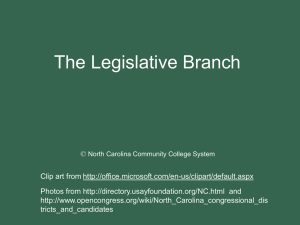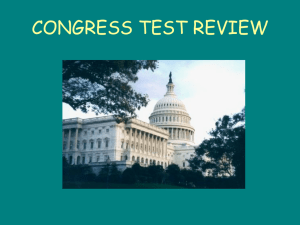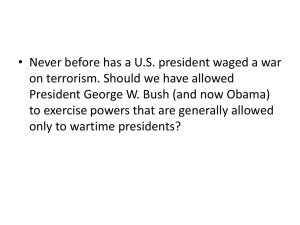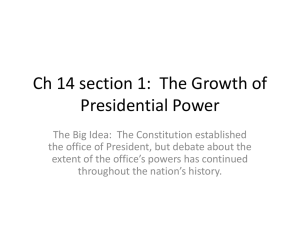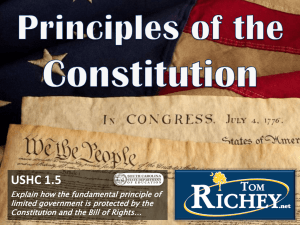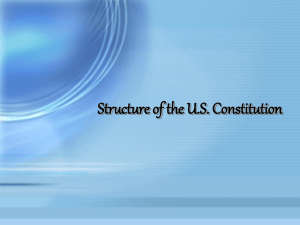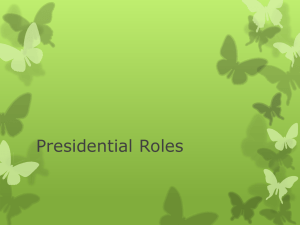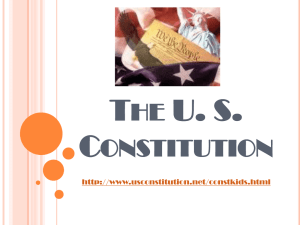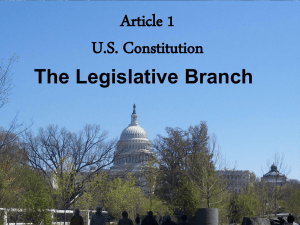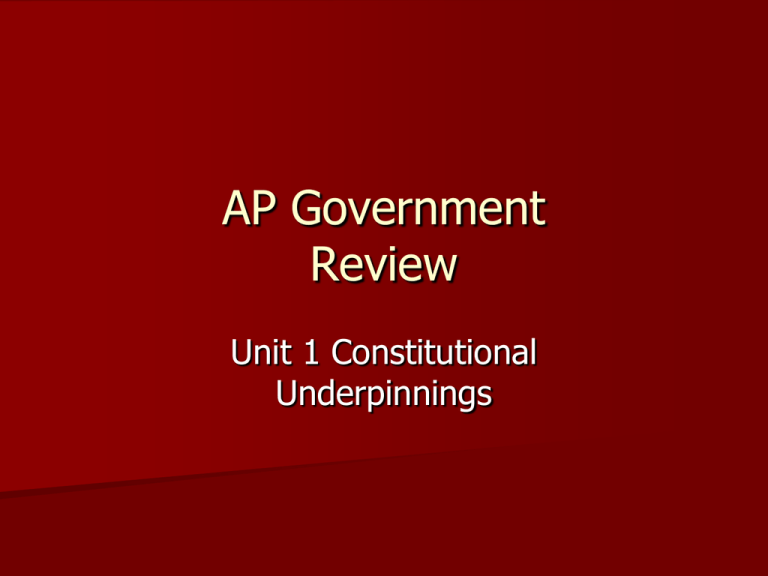
AP Government
Review
Unit 1 Constitutional
Underpinnings
Goals of the US Constitution
Create a strong union of states
Establish justice
Preserve Domestic Order
Provide for the common defense
Promote general welfare
Promote individual freedoms
Constitution Remedies the
Articles of Confederation
Creates Federalism
–
A balance between the national and state
governments
National government could tax
Congress could regulate commerce between
the states and foreign nations
Article II created an executive department to
enforce laws
Article III created a national judiciary with a
Supreme Court and lower courts established
by Congress
Constitution Remedies the
Articles of Confederation
Only the national government could coin
money
States are represented based on
population in the House of Reps and
equally in the Senate
Bills need a simple majority in the House
and Senate
2/3 of Congress and 3/4of the states are
necessary to amend the Constitution
Basic Principles of the Constitution
Limited government
Popular sovereignty
Separation of powers
Checks and balances
Federalism
Amendments
The Constitution has been formally
amended 27 times.
– Please know all the amendments
The first 10 amendments are known as
the Bill of Rights
Informal Amendments to the
Constitution
Legislative action: Judiciary Act of 1789
Executive actions: Executive orders
Judicial review: Marbury v. Madison
Custom and usage: No 3rd term for
Presidents
Federalism
Delegated powers
– Expressed powers given to the national government
Implied powers
– Powers that may be reasonably inferred from the
Constitution (Necessary and Proper Clause)
Inherent powers
– Powers that exist from the national government because the
government is sovereign
Concurrent powers
– Belong to both the states and national governments
Reserved powers
– Powers that belong to the states (Amendment 10)
Federalism In Practice
Interstate Relations
– Full faith and credit clause: states are required to
recognize the laws and legal documents of other
states
– Privileges and immunities clause: states are
prohibited from unreasonably discriminating against
residents of another state
– Extradition: states may return fugitives to states
which they fled
– Interstate compacts: states may work together to
solve regional problems
National Supremacy
Article IV Supremacy Clause
– McCulloch v. Maryland (1819) Federal law is
supreme over state law
– Gibbons v. Ogden (1824) National supremacy
over interstate commerce
Federalism Today
Dual Federalism (1789-1932)
– Layer cake federalism: National and state
have power within their own sphere of
influence
Cooperative Federalism (1932-1968)
– Marble cake federalism: National and state
work together
New Federalism (Nixon, Reagan, Bush 41)
– Devolution of national power to the states
Fiscal Federalism
Grant in aid
– Money and resources provided by the national government
to state and local projects and programs
Categorical grants
– Grants that have specific purpose defined by law
Block grants
– General grants which can be used for a variety of purposes
Unfunded mandates
– Requirements which are imposed by the national
government on the state and local governments
AP Government Review
Unit 2
Political Beliefs and Behaviors
Political Culture
A set of beliefs and basic values shared by
most citizens.
– Majority rule
– Free elections
– Equality in law
– Private property
– Individual freedoms
Political Socialization
The process in which citizens acquire a
sense of political identity
– Family and home life
– Education
– Group affiliations (interest groups, labor
unions)
– Demographic factors (age, sex, race, religion)
– Mass media
– Historical events
Public Opinion
A collection of shared attitudes of many
different people in matters relating to
politics, public issues, or making of public
policy.
Measuring Public Opinion
1930’s George Gallup developed polling:
– Sampling
– Preparing valid questions
– Controlling how the poll is taken
– Analyzing and reporting results
Political Ideology
A set of beliefs about politics and public
policy that creates the structure for
looking at government and public policy.
Political Spectrum
Radical: favor rapid, fundamental change in
existing social, economic, political order
Liberal: supports active government in
promoting individual welfare and social rights
Moderate: political ideology falls between liberal
and conservative
Conservative: promotes a limited government
role in helping individuals, supports traditional
lifestyle
Reactionary: advocates a return to a previous
state of affairs
AP Government Review
Unit 3
Political Parties
Interest Groups
Mass Media
Political Parties
An association of people who seek to control the
government through common principle.
Two Party System: There are several parties but
only two major parties compete and dominate
elections
Minor Parties: generally have little to no impact
on elections
What do Parties do?
Recruit candidates
Nominate and support candidates for
office
Educate the electorate
Organize the government (majority vs.
minority)
Party Identification
Ideology
Income
Race
Religion
Region of country
Education
Occupation
Gender
Family tradition
Marital status
Why a Two Party System
British heritage
Federalist/Anti-Federalist
Electoral system
Election laws
Electoral Dealignment and
Realignment
Dealignment: when significant number of
voters no longer support a particular party
Realignment: voting patterns shift and
new coalitions form.
– Republicans (1860)
– Democrats (1932)
Voting and Elections
Political Participation
Voting in elections
Discussing politics and attending political
meetings
Forming interest groups and PACs
Contacting public officials
Contributing money to a candidate or political
party
Running for office
Protesting government decisions
Issue or Policy Voting
Direct Primary
– Allows citizens to nominate candidates
Recall
– Is a special election initiated by petition to allow
citizens to remove an official from office
Referendum
– Allows citizens to vote directly on issues called
propositions
Initiative
– Allows voters to petition to propose issues to be
decided by qualified voters
Low Voter Turnout
Voter turnout is higher for Presidential
elections
Lower turnout for midterm elections
Lower when compared to other nations
Low Voter Turnout
Expansion of the electorate (26th Amendment)
Failure of the political parties to mobilize voters
No perceived differences between candidate or
party
Mistrust of the government
Apathy
Satisfaction with the way things are
Lack of political efficacy
Mobility of the electorate
Registration process
Types of Elections
Primary Election: voters choose candidates
from their party
Closed primary: only voters who are registered
in the party may vote to choose the candidate
Open primary: voters may vote to choose the
candidate of either party, whether they belong
to that party or not
Blanket primary: voters may vote for
candidates of either party
Runoff primary: when no candidate from a
party receives a majority of the votes, the top
two candidates face each other
Types of Elections
General Election
– Voters get to choose from among all the
candidates nominates by political parties or
running as independents
Electoral College
President and Vice-President are chosen by the
538 electoral votes
– 435 districts
– 100 senators
– 3 Washington DC
States use a winner take all method of assigning
their electoral votes based on popular vote
The candidate that receives a majority (270) is
declared winner.
If no winner is declared the House of
Representatives chooses the President and the
Senate chooses the Vice-President
Campaign Finance
Federal Election Campaign Act (1971)
– Restricted
Amount spent on campaign advertising
Required disclosure of contributions and expenditures
Federal Election Commission
– Enforces the FECA
– Created public financing for presidential candidates
Buckley v. Valeo (1976)
– The Supreme Court ruled that spending limits
established by the FECA were unconstitutional
Interest Groups and the Mass
Media
Interest Groups
Raise awareness and stimulate interest in
public affairs by educating their members
and the public
Represent membership, serving as a link
between members and the government
Provide information to the government
Provide channels for political participation
Types of Interest Groups
Economic Interest Groups
– Labor Groups (AFL-CIO)
– Business Groups (Chamber of Commerce)
– Professional Groups (National Education
Association)
– Agricultural Groups (National Farmer’s Union)
AP Government Review
Unit 4
The Legislative, Executive, and
Judicial Branches
The Legislative Branch
Congress
Article I of the US Constitution creates a
bicameral legislature consisting of the
House of Representatives and the Senate
The current structure was a result of the
Connecticut or Great Compromise reached
at the Constitutional Convention
House of Representatives
Membership
– 435 members apportioned by population
Term of Office
– 2 years; entire House elected every 2 years
Qualifications
– At least 25 years old
– Citizen for 7 years
– Must live in state where district is located
Constituencies
– smaller, by district
Prestige
– Less prestige
House of Representatives
Getting Elected
Apportionment: distribution among the states
based on the population of each state
Reapportionment: the redistribution of
Congressional seats after the census
determines changes in population distribution
among the states
Congressional districting: the drawing by state
legislatures of congressional districts for those
states with more than one representative
Gerrymandering: drawing congressional
districts to favor one political party or group
over another
House of Representatives
Leadership
– Speaker of the House
Presiding officer and most powerful member
Assigns bills to committee
Controls floor debates
Appoints party members to committees
– Majority Leader
Assistant to the Speaker
Helps plan party’s legislative program
Directs floor debates
– Minority Leader
Major spokesperson for the minority party
Organizes opposition to the majority party
House of Representatives
How a Bill becomes a Law
A bill is introduced, numbered, and assigned to a
committee
The bill may be assigned to a subcommittee for
further study
The bill is returned to committee where it is approved
or rejected
The rules committee sets terms of debate for the bill
The bill is debated by the House
A vote is taken. Bills that pass go to the Senate
Conference committee resolves any differences
between House and Senate Bill
Resolved bill is voted on in the House
If approved, sent to the President
US Senate
Membership: 100 members (2 from each state)
Term of office: 6 years; staggered terms with
one-third of the Senate elected every 2 years
Qualifications:
– At least 30 years of age
– Citizen for 9 years
– Must live in state
Constituencies: Larger, entire state
Prestige: More prestige
US Senate
Getting Elected
– Members were originally chosen by the state
legislatures in each state
– Since 1913, the 17th Amendment allows the
direct election of senators by the people of
the state
US Senate
Leadership
– US Vice President
Presiding officer of the Senate.
Cannot debate and only votes to break a tie
– President pro tempore
Senior member of the majority party
A ceremonial position
– Majority leader
The most influential member of the Senate
The majority party’s spokesperson
– Minority leader
Performs the same role as the House minority leader
US Senate
How a Bill becomes a Law
A bill is introduced, numbered, and assigned to a committee
The bill may be assigned to a subcommittee for further study
The bill is returned to committee where it is approved or
rejected
No rules committee!
The bill is debated by the Senate
A vote is taken, where the bill is passed or defeated. Bills
that pass the Senate are sent to the House
Conference committee resolves any differences between
House and Senate Bill
Resolved bill is voted on in the Senate
If approved, sent to the President
Congressional Override
If the President vetoes the bill then it is
returned to the Congress, where they may
override the veto by a two-thirds vote in
each house.
Types of Committees
Standing
– A permanent committee that deals with specific policy
matters (agriculture, energy…)
Select
– A temporary committee appointed for a specific purpose
(Senate Watergate Committee)
Joint
– Made up of members of both Houses (Joint Committee
on the Library of Congress)
Conference
– A temporary committee of members from both Houses,
created to resolve differences in the House and Senate
versions of the bill
Caucuses
Informal groups formed by members of
Congress who share a common purpose of
goals
– Congressional Black Caucus
– Women’s Caucus
– Democratic or Republican Caucus
Roles of Members of Congress
Policymaker
Representative
Constituent servant
Committee member
Politician/Party member
House of Representatives/Senate
Incumbency Effect: the tendency for office holders to
easily get reelected
– Name recognition
– Credit claiming (bringing positive results to the district or
state)
– Casework for constituents (helped constituents solve
problems)
– More visible to constituents
– Media exposure
– Fundraising abilities
– Experience in campaigning
– Voting record
Powers of Congress
Legislative Powers
– Expressed powers: Powers specifically granted to
Congress, mostly found in Article I, Section 8 of
the Constitution
– Implied powers: powers which may be
reasonably suggested to carry out the expressed
powers; found in Article I, Section 8, Clause 18,
“necessary and proper”
– Limitations of powers: power denied Congress in
Article I, Section 9 and the 10th Amendment
Powers of Congress
Non-Legislative Powers
Electoral powers: selection of the President by the House and
Vice-President by the Senate upon the failure of the electoral
college to achieve a majority vote
Amendment powers: Congress may propose amendments by
2/3 votes of each house
Impeachment:
– House may bring charges, or impeach, the President, Vie-President, or
any civil officer by a simple majority
– Senate holds the trial and acts as a jury with a 2/3 vote needed to find
guilt
Executive powers of the Senate:
– Must approve appointees by the Executive Branch by a simple majority
– Must approve treaties by a 2/3 vote
Investigation/oversight powers: investigate matters falling
within the range of its legislative authority
Legislative Tactics
Caucuses: may form voting blocs
Committee system
Filibuster or Cloture: in the Senate only, unlimited
debate in an attempt to stall action on a bill;
cloture is the method by 60 votes to end a filibuster
Pork barrel legislation: an attempt to provide funds
and projects for a member’s home state or district
Logrolling: an attempt by members to gain support
of other members in return for their support on the
member’s legislation
Legislative Tactics
Riders: additions to legislation which generally have
no connection to the legislation
Amendments: additions or changes to the legislation
which deal specifically with the legislation
Lobbying: trying to influence members of Congress to
support or reject legislation
Conference committee: may affect the wording and
therefore intent of the legislation
Legislative veto: the rejection of a presidential or
executive branch action by one or both houses of
Congress, used mostly between 1932-1980.
– Declared unconstitutional in the 1983 case, Immigration and
Naturalization Service v. Chada
Influences on Congress
Constituents
Other lawmakers and staff
Party influences
President
Lobbyists and interest groups
Executive Branch and the
Bureaucracy
President of the United States
Article II of the Constitution establishes
the many responsibilities and functions of
the President
Term and Tenure
– 4 year term
– 2 terms (10 year max) 22nd Amendment
President of the United States
Formal Qualifications
– Natural born citizen
– At least 35 years old
– Resident of the US 14 years prior to election
Informal, many presidential candidates share
several characteristics
–
–
–
–
–
–
Political or military experience
Political acceptability
Married
White male
Protestant
Northern European ancestry
Succession and Disability
The Constitution provides that if the
President can no longer serve in office the
Vice-President will carry out the powers
and duties of the office
25th Amendment
– The Vice-President becomes President if the
office of the president becomes vacant
– The President will nominate a new VicePresident, with approval of a majority from
both houses of Congress
Impeachment and Removal
The Constitution gives the House of
Representatives the authority to bring
charges against the President or VicePresident for “Treason, Bribery, or other
High Crimes and Misdemeanors.”
Once charges are brought the Senate
holds the trial. The Chief Justice of the
Supreme Court presides over the trial
Conviction requires a 2/3 vote
Electoral College System
12th Amendment
– An electoral college elects the President and Vice-President
– Each state chooses the number of electors equal to its
number of members in the House of Representatives and
Senate.
– In December, after the general election, the electors meet in
their state capital to cast their ballots for president and vicepresident.
– The electoral college then sends its ballots to the President
of the US Senate where they are opened before a joint
session of Congress
– To win a candidate needs a majority (270)
– If a majority is not reached the House votes on the top 3
candidates for President and the Senate votes on the top 2
candidates for Vice-President
The Vice-Presidency
Presides over the Senate, casting tiebreaking votes
Help determine presidential disability
under the 25th Amendment and take over
presidency if necessary
Has the same formal qualifications as the
President
Presidential Powers
Executive powers
– Enforces laws, treaties, and court decisions
– Issues executive orders to carry out policies
– Appoints officials, removes officials
– Assumes emergency powers
– Presides over cabinet and executive branch
Military powers
– Serves as commander in chief
– Has final decision making authority in matters
of national and domestic defense
– Provides for domestic order
Presidential Powers
Legislative Powers
–
–
–
–
–
Gives annual State of the Union message
Issues annual budget and economic reports
Signs or vetoes bills
Proposes and influences legislation
Calls for special sessions of Congress
Diplomatic Powers
–
–
–
–
–
Appoints ambassadors and other diplomats
Negotiates treaties and executive agreements
Meets with foreign leaders
Accords diplomatic recognition to foreign governments
Receives foreign dignitaries
Presidential Powers
Judicial Powers
– Appoints members of the federal judiciary
– Grants reprieves, pardons, and amnesty
Party Powers
– Leader of the party
– Chooses vice presidential nominee
– Strengthens the party by helping members
get elected (coattails)
– Appoints party members to government
positions (patronage)
– Influences policies and platform of party
Limitations on Presidential Powers
Congressional Checks
–
–
–
–
–
Override presidential veto
Power of the purse
Power of impeachment
Approval powers over appointees
Legislation limiting the president’s power (War Powers Act)
Judicial Checks
– Judicial review of executive action
Political checks
– Public opinion
– Media attention
– popularity
The Bureaucracy
The Bureaucracy
A systematic way of organizing a complex
and large administrative structure.
– Hierarchical authority: similar to a pyramid
with the top having authority over those
below
– Job specialization: each worker has defined
duties and responsibilities, a division of labor
among workers
– Formal rules: established regulations and
procedures which must be followed
History and Growth
Beginnings: standards for office included qualifications
and political acceptability
Spoils system: practice of giving offices and
government favors to political supporters and friends
Reform movement: competitive exams were tried and
failed due to inadequate funding from Congress
Pendleton Act: Civil Service Act of 1883, replaced the
spoils system with a merit system
Hatch Act of 1939: prohibits government employees
from engaging in political activities while on duty
Civil Service Reform Act of 1978: created the office of
Personnel Management to recruit, train, and establish
classifications and salaries for federal employed
Organization
The federal bureaucracy is divided into four
basic types
– Cabinet departments (15 executive
departments)
– Independent executive departments (NASA,
Small Business Administration)
– Independent regulatory agencies (Securities
and Exchange Commission, Federal Reserve
Board)
– Government corporations (Tennessee Valley
Authority, US Postal Service)
Influences on the Federal
Bureaucracy
Executive influences: appointing the right
people, issuing executive orders, affecting the
agency’s budget
Congressional influences: influencing
appointments, affecting the agency’s budget,
holding hearings, rewriting legislation
Iron triangles: alliances between bureaucratic
agencies, congressional committees, and
interest groups
Executive Office of the President
White House Office
National Security Council
Office of Management and Budget
Office of Faith Based and Community
Initiatives
Office of National Drug Control Policy
Office of Policy Development
Council of economic Advisors
Office of US trade Representative
Executive Departments
State
Treasury
Defense
Interior
Justice
Agriculture
Commerce
Labor
Health and Human
Services
Housing and Urban
Development
Transportation
Energy
Education
Veterans affairs
Homeland Security
The Judicial Branch
The Federal Court System
The US has a dual court system of courtsa federal court system and the court
system of the 50 states
Article III of the Constitution states that
there shall be a Supreme Court and that
Congress may establish a system of
inferior courts
Jurisdiction
Original jurisdiction
– Lower courts have the authority to hear cases for
the first time.
District Court conducts trials, evidence is presented, and
juries determine the outcome of the case
Supreme Court has original jurisdiction in cases involving
representatives of a foreign government, and certain
types of cases where a state is a party
Appellate jurisdiction
– Courts that hear reviews or appeals of decisions
from the lower courts
Court of Appeals
Supreme Court
Structure of the Judicial System
District Courts
– Created by the Congress in the Judiciary Act of 1789.
– There are 94 District Courts
– Decide civil and criminal cases
Court of Appeals
– Created by Congress in 1891
– There are 13 US Court of Appeals
– Decide appeals from the District Courts
Supreme Court
– Created by Article III of the Constitution
– Most of its cases are appeals from the US Court of Appeals
and State Supreme Courts
– Has original and appellate jurisdiction
Judicial Selection
The President appoints all federal judges
with confirmation from the US Senate
There are no formal qualifications
Serve a life term
Federal judges may be removed through
impeachment
Supreme Court Selection
Presidents only make appointments to the
Supreme Court if a vacancy occurs during their
term of office
When making appointments, Presidents often
consider:
– Party affiliation
– Judicial philosophy
– Race, gender, religion, region
– Judicial experience
– Political ideology
– Acceptability
The Supreme Court at Work
The term of the Supreme Court begins on
the first Monday in October and generally
lasts until June or July of the following
year.
Accepting Cases
Cases that are accepted must pass the rule of
four: four of the nine justices must agree to
hear the case.
– Writ of certiorari: an order by the court directing
the lower court to send up the records of a case for
review
– Certificate: a lower court may ask the Supreme
Court about a rule of law or procedures in specific
cases
Briefs and Oral Arguments
Once a case reaches the Supreme Court,
lawyers for each party to the case file a written
brief
– Written briefs include: detailed statements of the
facts of the case supported by relevant facts and
citations from previous cases
Interested parties may be invited to submit
amicus briefs (friends of the court) supporting
or rejecting arguments of the case
Oral arguments allow both sides 30 minutes to
present their positions to the justices
Writing Opinions
Once the Supreme Court has made a decision in a
case, the decision is explained in a written statement
– Majority opinion: a majority of the justices agree on the
decision and its reasons
– Concurring opinion: a justice who agrees with the majority
opinion but not the reasoning behind the decision
– Dissenting opinion: a justice or justices who disagree with
the majority opinion
Majority opinions become precedent in deciding future
cases
Judicial Activism
Holds that the court should play an active
role in determining national policies
The philosophy advocates applying the
Constitution to social and political
questions
Judicial Restraint
Holds that the court should avoid taking
the initiative on social and political
questions.
Operating strictly within the limits of the
Constitution
AP Government Review
Unit 5
Politics and Public Policymaking
Agenda-Setting
Recognizing an issue as a problem which must
be addressed as a part of the political agenda.
Problems are brought to the political agenda by:
–
–
–
–
Citizens
Interest groups
The Media
Government Entities
Formation/Adoption/
Implementation
Formation: finding ways to solve the
problems
Adoption: adopting a plan of action to
solve the problem; may require legislation
Implementation: executing the plan of
action by appropriate
agency or agencies
Policy Evaluation
Analysis of policy and its impact upon the
problem
Judging the effectiveness of policy
Domestic Policy
Crime Prevention: FBI, DEA, & ATF
Education: States run education but since
the creation of the Department of
Education (1979) the Fed has used
grants and vouchers as influence
Energy: The study of alternative and
renewable sources of fuel. Regulates
nuclear waste.
Domestic Policy
Health Care: Medicare (elderly),
Medicaid (poor), CDC, VA,
FDA
Social Welfare: Social Security, Housing
Programs,unemployment
benefits
Economic Policy
Raising Revenue: income tax, cooperate
tax, estate tax, customs
Government Spending
–
Discretionary Spending
–
Defense, Education, Student Loans, Scientific
Research, Environmental Clean-up, Law Enforcement,
Disaster Aid, Foreign Aid
Nondiscretionary Spending
Interest of the national debt, social welfare programs
Economic Policy
Federal Budget: Proposed each year
(fiscal year is October 1
through September 30)
– Proposals
Each federal agency must submit a budget request
to the Office of Management and Budget.
The President submits a budget proposal to
Congress based on the OMB
The Congress proposes its own budget based on
the advise of the Congressional Budget Office
Economic Policy
The budget must be passed by Congress
and signed by the President by September
15.
Failure to pass a budget could lead to the
federal government to shut down.
AP Government Review
Unit 6
Civil Liberties and Civil Rights
Civil Liberties
Constitution
– Writ of habeas corpus: you must be brought
before the court and informed of charges
against you
– No bills of attainder: you cannot be punished
without a trial
– No ex post facto laws: laws applied to acts
committed before the laws’ passage are
unconstitutional
– Trial by jury
Civil Liberties
Bill of Rights
– Freedom of religion, speech, press, petition,
and assembly
– No unreasonable search and seizure
– Protections against self-incrimination and
double jeopardy
– Protections in criminal procedures
Civil Liberties
14th Amendment
– Provided for the expansion of the Bill of
Rights to the states and local governments
– Incorporation
Legislation
– Laws that set limits or boundaries on one
person’s rights over another person
Courts
– Judicial review
Freedom of Religion
Establishment Clause
Congress cannot:
– Establish a national religion
– Favor one religion over another
– Tax citizens to support any one religion
Freedom of Religion
Establishment Clause
Please know the following Supreme Court
cases
– Engle v. Vitale
– Abington Township v. Schempp
– Lemon v. Kurtzman
– Minersville v. Gobitus
– West Virginia v. Barnette
– Wallace v. Jaffree
Freedom of Religion
Free-Exercise Clause
Guarantees the right to practice any
religion or no religion at all
Know these cases
– Reynolds v. United States
– Wisconsin v. Yoder
– Oregon v. Smith
– Church of the Lukumi Babalu Aye v. City of
Hialeah
Freedom of Speech
Pure Speech: the most common form of
speech, verbal speech
Symbolic Speech: using actions or symbols
to convey an idea
Speech Plus: verbal and symbolic speech
used together
Freedom of Speech
Know these cases
– Abrams v. United States
– Schenck v. United States
– Gitlow v. New York
– Tinker v. Des Moines
– Texas v. Johnson
– Reno v. ACLU
Freedom of the Press
Know these cases
– Near v. Minnesota
– New York Times v. Sullivan
– New York Times v. United States
– Hustler v. Falwell
– Hazelwood School District v. Kuhlmeier
Freedom of Assembly
The government is allowed to set limits on
assembly to protect the rights and safety
of others
– Dejonge v. Oregon
Property Rights
The due process clause of the 5th and 14th
Amendments provide for the protection of
private property by guaranteeing :life,
liberty, or property, without due process
of the law”
Due Process
Substantive due process
– Involves the policies of government or the
subject matter of the laws, determining
whether the law is fair or if it violates
constitutional protections
Procedural due process
– The method of government action or how the
law is carried out, according to established
rules and procedures
Right to Privacy
The Constitution makes no mention of a
“right to privacy,” however the Supreme
Court has interpreted several rights that
may fall under the category of privacy
– Griswold v. Connecticut
– Roe v. Wade
Fourth Amendment
Search and Seizure
Know these cases
– Wolf v. Colorado
– Mapp v. Ohio
– TLO v. New Jersey
– Weeks v. United States
– Katz v. United States
Fifth Amendment
Self-Incrimination
Know this case
– Miranda v. Arizona
Sixth Amendment
Right to an Attorney
Know these cases
– Powell v. Alabama
– Gideon v. Wainwright
Eighth Amendment
Cruel and Unusual Punishments
Know these cases
– Furman v. Georgia
– Gregg v. Georgia
Civil Rights
Are the positive acts of government,
designed to prevent discrimination and
provide equality before the law
The Equal Protection Clause of the 14th
Amendment prevents the states from
discriminating against citizens.
Civil Rights Movement
13th Amendment abolished slavery
14th Amendment defined citizenship and
provided due process and equal protection
15th Amendment provided that all males
21 and older could vote
24th Amendment outlawed the poll tax in
federal elections
Civil Rights Movement
Black codes: state laws passed to keep
freed slaves out of politics (literacy test,
poll tax, registration tests)
Civil Rights Act of 1876: outlawed racial
segregation in public places
Jim Crow Laws: created segregation in
schools, public transportation, and hotels
Plessy v. Ferguson: separate but equal
facilities are constitutional
Civil Rights Movement
Executive Order 8802: Franklin Roosevelt
banned racial discrimination in the federal
government
Executive Order 9981: Harry Truman
ordered the desegregation of the military
Brown v. Board of Education: overturned
Plessy v. Ferguson, separate but equal is
unconstitutional
Civil Rights Movement
Civil Rights Act of 1964: prohibited
discrimination in employment and in
places of public accommodations
Voting Rights Act of 1965: outlawed
discriminatory tests in voter registration
The Women’s Movement
19th Amendment gave women the right to
vote
Equal Pay Act of 1963: made it illegal to
base a person’s pay on their gender, race,
religion, or national origin
Equal Employment Opportunity Act of
1972 prohibited gender discrimination in
hiring, firing, promotions, and pay
People with Disabilities
The Rehabilitation Act of 1973 prohibited
discrimination against people with
disabilities in federal programs
The Americans with Disabilities Act of
1990forbids employers from discriminating
against people with disabilities
Affirmative Action
A policy designed to correct the effects of
past discrimination.
University of California v. Bakke (1978):
the court ruled that affirmative action was
constitutional but that Bakke had been
denied equal protection because the
university used race as the sole criteria for
admissions

